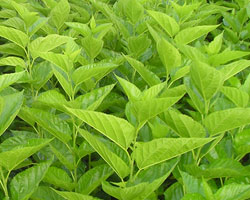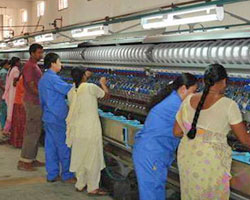IMPACT OF CSB'S R&D ON SERICULTURE
Sericulture plays a vital role in determining the economy of tribal population in India. Even if, the contribution of sericulture is not very high but it helped to increase the socio economic conditions of farmers. Muga silkworm culture is not only a tribal based industry but it is also a foreign exchange earner. Consequently any Research and Development programme aimed at the improvement of productivity potential of the muga silkworm contributes to:
(i) The rural employment
(ii) Socioeconomic development of the tribal without environmental damage
(iii) The foreign exchange reserves
Muga sericulture is exclusive art for most of the people of North Eastern region and main sources of income. For this reason, it possesses the key to their socio economic welfare. Therefore, it can be reckoned that any obstacles in sericultural development can be hazardous to the economy of tribal population in India. The good news is that technology has helped to overcome many of these obstacles with some very advantageous results. The technologies developed by R& D institutes of Central Silk Board (CSB) have been popularized among the farmers to maximize yield and returns which in turn resulted in bringing out vertical growth of the industry.
The annual mulberry raw silk production has increased to the tune of 23,060 M.T. (2011-12), which includes 18,272 MT mulberry silk, 1,590 MT Tasar silk, 3,072 MT Eri silk and 126 MT Muga silk. The constant efforts made by CSB and state sericulture department have resulted in the over all increase in the silk production and quality.
Scientists working in sericulture Research and Development are constantly putting their efforts to resolve issues in major areas of sericulture such as silkworm and host plant improvement, pest and disease management, and reduction in cost of production by developing new innovations and technologies and improving the quality of silk fibers to match with international standards. CSB has also been collaborating with both international and national agencies and universities involved in sericultural research, etc., to harness their technical expertise in highly specialized fields and also to pool resources for the development of new technologies in frontier areas of sericulture research.
Over the past few decades, the silk industry made good progress with regard to productivity and quality of the output. The productivity of mulberry plantation in terms of silk which used to be less than 40 kg per hectare per year has reached 86 kg per hectare per year besides enhancing India’s capability to produce silk of international grades. This could be possible due to evolution of high yielding mulberry varieties such as V1, S1635, S1, S799, S13, S34, S146, BC259, Tr10 and improved silkworm breeds like CSR2xCSR4, CSR2xCSR5, SH6xKA, SH6xNB4D2, NB18xP5, YS3xSF19, Dun6xDun22, etc along with appropriate cultivation and rearing practices. The output coupled with the improved processing machinery and practices have made it possible to produce silk of international standards.
Leaf productivity of muga food plants has increased from 10 to 11 kg per plant per year and the cocoon productivity has increased from 40 to 60 cocoons per dfls.
The major achievements during XI Plan are as follows.
Mulberry

- Three high yielding mulberry varieties, viz., Vishala V1 and Anantha were authorised. Vishala qualified for cultivation throughout the country while V1 and Anantha were recommended for southern zone only.
- 18 new mulberry silkworm hybrids were authorized for use. They are eight bivoltine hybrids, viz., APS105x APS126, APS45 x APS12, CSR46 x CSR47, Dun17 X Dun18, GEN3 x GEN2, KSO1 x NP4, NK2 x NP4, SLD4 x SLD8; seven multivoltine x bivoltine hybrids, viz., APDR15 x APDR115, APM2 x APDR105, APM3 x APS12, Mcon1 x Bcon4, Mcon4 x Bcon4, MH1 x CSR2 and PM x CSR2(SL); and three multivoltine hybrids, viz., M con1 X M con4, Nistari X M con4 and PM X C110. Including these, a total of 54 mulberry silkworm hybrids have been authorised.
- The multivoltine x bivoltine hybrid, APDR15xAPDR115 has shown the highest yielder of 70-75 kg/100 dfls.; PMxC110 a multivoltine hybrid, showed the highest yield of 40-45 kg/100dfls and this can be well used in summer in the eastern region.
- Long term seed preservation schedule was developed for the multivoltine x bivoltine hybrid, PM x CSR2 to preserve the seed up to 50 days. This reduces the wastage of silkworm seed due to shorter shelf life to considerable extant.
- Papaya mealy bug, Paracoccus marginatus that lead to devastation of mulberry in Tamil Nadu was brought under control using exotic bio-control agents, Acerophagus papaya, Anagyrus loecki, and Pseudleptomastix mexicanaimported from Puerto Rico. Their multiplication and maintenance was standardized and popularized.
- Developed and commercialised the bed disinfectants, ‘Amruth’, ‘Rakshak’ and ‘Decol’ to control the spread of disease causing germs in the silkworm beds.
- A phyto-ecdysone, ‘Sampoorna’ was isolated from plants and commercialized for its use in hastening the spinning process of cocoons.
- ‘Navinya’ comprising of plant 80% derivatives was developed to control root-rot disease.
- During the plan period, 11 patents were obtained and 18 technologies were commercialized.
Tasar
- A protocol for vegetative propagation of Terminalia arjuna and T. tomentosa, using juvenile stem cuttings was standardised. It is now possible to propagate the plants true to their parents.
- Protocols for in vitro propagation of Shorea robusta was standardised.
- Eight eco-races of A. mylitta (Daba BV, Daba TV, Sukinda, Sarihan, Modal, Modia, Raily, Laria) were maintained in the Germplasm Bank.
- Indoor rearing method for tasar silkworm was improvised. Scaling up experiments is required.
- Semi-synthetic diet was developed for young tasar silkworms.
- ‘Jeevan Dhara’ a plant based powder was developed to check the spread of viral infection in tasar silkworms. The reduction in infection was by 36-54%.
- A complex of Leaf Surface Microbes was prepared for the control foliar diseases of arjun and asan plants.
- Protocols for seed cocoon preservation and seed preparation were standardized for the second (autumn) oak tasar crop in the north eastern region of India.
Post Cocoon Technology

- Designed and developed automatic conveyor cooking machine for medium scale reeling establishments
- Designed and developed dupion silk reeling machine to produce superior grade silk
- Process for eri mill spinning was standardized
- Designed and developed improved silk handloom, Ball to Beam warping machine, Hank to pirn winder for handloom sector
- Tasar silk wet reeling package was developed
- A technique for development of fancy yarns from Spun silk was developed
- Low cost 10 basin multiend reeling machine with 8 ends / basin has been developed for mulberry silk reeling
- Introduced solar water heating system along with mini boiler for cooking and reeling for multi-end reeling unit
- Eight ends multi-end reeling unit suitable for tasar and muga cocoon reeling with individual break stop motion capable of producing superior quality yarn with higher productivity has been developed
- A low cost solar operated spinning machine suitable for spinning all types of non-mulberry wastes and also mulberry waste into good quality yarn with higher productivity has been developed
- A twin shuttle loom has been designed and developed specifically for the requirement of North Eastern states to weave simultaneously two narrow width fabrics
It is a well known fact that advancements in technology have altogether changed the way we perform various day to day tasks. Innovative technological inventiveness has totally modified every aspect of our life. There was a time when benefits from sericulture were very less and the farmers were leading miserable life. Thanks to technological inventions they can now work with full satisfaction and earn good remunerative. In fact, farmers can now produce much more than their forefathers used to do.
Once technology and sericulture were considered as entirely different realms of experience. However, today they’re thought of as partners, technology has benefited farmers in many diverse ways. Technology has helped them realize dreams that were thought impossible just a few decades ago. Today, suitable techniques have been developed for clonal propagation of the silk host plant and it helped to harvest quality cocoons. New silkworm hybrids have been developed and disease forecasting and forewarning technology has been fine tuned to minimize pest population in sericultural areas. Today’s farmer understands the fact that working with new technologies not only saves his time, but also improves the quality of his outcome. It is unfortunate that deforestation, environmental pollution, out break of diseases and pest population due to harsh ecological conditions, are declining the benefits of sericulture. However, technological creativity has improved the quantity as well as the quality of sericultural production, encouraging more people to adopt sericulture as a profitable business.
| For further details contact: | |
|---|---|
| Director (Technical), Central Silk Board, CSB Complex, BTM Layout, Madivala, BANGALORE - 560 068. | |
| +91 80 26681638 [O] +91 80 28282610 +91 80 26577712 [R] +91 80 26681511 | |
| dirtech.csb@nic.in | |






